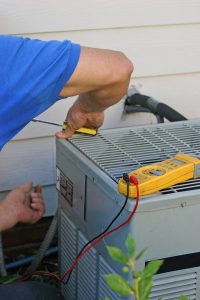 You might call it Freon or maybe know it by another brand name, but the chemical refrigerant that’s inside your AC is an essential component allowing the system to do its job. Without refrigerant, your air conditioning system is nothing more than a large central house fan. Fans can help out a bit in hot weather—in fact, we recommend homeowners turn their ACs to “fan only” mode during the milder hot weather to help save energy. But if you want to endure an intense Texas summer, you’ll need an air conditioner system that actually draws heat from the air to cool it down. And for that, the AC needs refrigerant.
You might call it Freon or maybe know it by another brand name, but the chemical refrigerant that’s inside your AC is an essential component allowing the system to do its job. Without refrigerant, your air conditioning system is nothing more than a large central house fan. Fans can help out a bit in hot weather—in fact, we recommend homeowners turn their ACs to “fan only” mode during the milder hot weather to help save energy. But if you want to endure an intense Texas summer, you’ll need an air conditioner system that actually draws heat from the air to cool it down. And for that, the AC needs refrigerant.
But people often don’t understand exactly how refrigerant works in an air conditioner. For example, a question that HVAC professionals sometimes hear from customers is when they should have more refrigerant put into the system. The answer is, “Hopefully, never.” We’re here to give you some facts about refrigerant, which will help you know when your AC needs repair work done.
Refrigerant Is Not a Fuel
This is the big misunderstanding people often have about refrigerant: that it’s an energy source powering the air conditioner much the same way gasoline powers a vehicle.
Here’s what refrigerant actually is: a chemical blend that allows for the transfer of heat from one place to another. The actual energy source of the air conditioner is electricity. The system consumes electricity to power the components that circulate the refrigerant. The energy applied to the refrigerant causes it to heat up and turn into a high-pressure gas, which in turn makes it move through the AC system, first to condense in the outdoor coil and release heat, then to pass through the indoor coil and evaporate to absorb heat. This switch between hot gas and cold liquid is why the air conditioner can cool down a home.
And what happens to the refrigerant as it changes from gas to liquid and back again? None of it gets used up, and none of it dissipates. The refrigerant will remain at the same level (called the charge or the AC) for the life of the system, continually circulating.
Refrigerant Can Leak
Ideally, a homeowner should never need to have professionals add any R-410A (the refrigerant found in most ACs) to the air conditioner. But conditions aren’t always ideal, and there is one situation where more refrigerant has to be added: when refrigerant leaks from corroded copper lines. In this case, recharging the refrigerant isn’t a routine “fill-up” service, it’s a repair. Professionals must first seal the leaks and then ensure the refrigerant is recharged to factory set levels—an overcharged air conditioner will malfunction, which is why only licensed technicians should handle jobs with refrigerant.
If you are dealing with refrigerant leak, it’s time to call us for air conditioning repair in Katy, TX. Watch for signs such as a drop in cooling power, ice on the evaporator coil, or hissing sounds from the unit.
At AC Comfort, we believe that comfort can cost less! Repair your AC with our technicians and you’ll see how!

